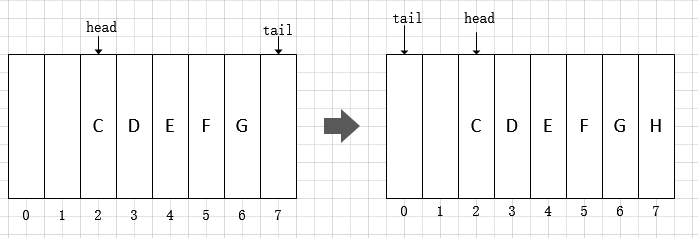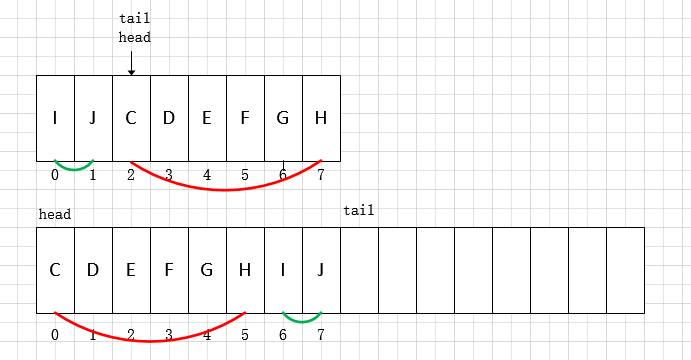Queue 也是 Java 集合框架中定义的一种接口,直接继承自 Collection 接口。除了基本的 Collection 接口规定测操作外,Queue 接口还定义一组针对队列的特殊操作。通常来说,Queue 是按照先进先出(FIFO)的方式来管理其中的元素的,但是优先队列是一个例外。
Deque 接口继承自 Queue接口,但 Deque 支持同时从两端添加或移除元素,因此又被成为双端队列。鉴于此,Deque 接口的实现可以被当作 FIFO队列使用,也可以当作LIFO队列(栈)来使用。官方也是推荐使用 Deque 的实现来替代 Stack。
ArrayDeque 是 Deque 接口的一种具体实现,是依赖于可变数组来实现的。ArrayDeque 没有容量限制,可根据需求自动进行扩容。ArrayDeque不支持值为 null 的元素。
下面基于JDK 8中的实现对 ArrayDeque 加以分析。
方法概览
1
2
3
4
5
6
7
8
9
10
11
12
13
14
15
16
17
18
19
20
21
22
23
24
25
|
public interface Queue<E> extends Collection<E> {
//向队列中插入一个元素,并返回true
//如果队列已满,抛出IllegalStateException异常
boolean add(E e);
//向队列中插入一个元素,并返回true
//如果队列已满,返回false
boolean offer(E e);
//取出队列头部的元素,并从队列中移除
//队列为空,抛出NoSuchElementException异常
E remove();
//取出队列头部的元素,并从队列中移除
//队列为空,返回null
E poll();
//取出队列头部的元素,但并不移除
//如果队列为空,抛出NoSuchElementException异常
E element();
//取出队列头部的元素,但并不移除
//队列为空,返回null
E peek();
}
|
Deque 提供了双端的插入与移除操作,如下表:
|
|
First Element (Head) |
|
Last Element (Tail) |
|
Throws exception |
Special value |
Throws exception |
Special value |
| Insert |
addFirst(e) |
offerFirst(e) |
addLast(e) |
offerLast(e) |
| Remove |
removeFirst() |
pollFirst() |
removeLast() |
pollLast() |
| Examine |
getFirst() |
peekFirst() |
getLast() |
peekLast() |
Deque 和 Queue 方法的的对应关系如下:
| Queue Method |
Equivalent Deque Method |
| add(e) |
addLast(e) |
| offer(e) |
offerLast(e) |
| remove() |
removeFirst() |
| poll() |
pollFirst() |
| element() |
getFirst() |
| peek() |
peekFirst() |
Deque 和 Stack 方法的对应关系如下:
| Stack Method |
Equivalent Deque Method |
| push(e) |
addFirst(e) |
| pop() |
removeFirst() |
| peek() |
peekFirst() |
ArrayList 实现了 Deque 接口中的所有方法。因为 ArrayList 会根据需求自动扩充容量,因而在插入元素的时候不会抛出IllegalStateException异常。
底层结构
1
2
3
4
5
6
7
8
|
//用数组存储元素
transient Object[] elements; // non-private to simplify nested class access
//头部元素的索引
transient int head;
//尾部下一个将要被加入的元素的索引
transient int tail;
//最小容量,必须为2的幂次方
private static final int MIN_INITIAL_CAPACITY = 8;
|
在 ArrayDeque 底部是使用数组存储元素,同时还使用了两个索引来表征当前数组的状态,分别是 head 和 tail。head 是头部元素的索引,但注意 tail *不是尾部元素的索引,而是尾部元素的下一位*,即下一个将要被加入的元素的索引。
初始化
ArrayDeque 提供了三个构造方法,分别是默认容量,指定容量及依据给定的集合中的元素进行创建。默认容量为16。
1
2
3
4
5
6
7
8
9
10
11
12
|
public ArrayDeque() {
elements = new Object[16];
}
public ArrayDeque(int numElements) {
allocateElements(numElements);
}
public ArrayDeque(Collection<? extends E> c) {
allocateElements(c.size());
addAll(c);
}
|
ArrayDeque 对数组的大小(即队列的容量)有特殊的要求,必须是 2^n。通过 allocateElements 方法计算初始容量:
1
2
3
4
5
6
7
8
9
10
11
12
13
14
15
16
17
18
|
private void allocateElements(int numElements) {
int initialCapacity = MIN_INITIAL_CAPACITY;
// Find the best power of two to hold elements.
// Tests "<=" because arrays aren't kept full.
if (numElements >= initialCapacity) {
initialCapacity = numElements;
initialCapacity |= (initialCapacity >>> 1);
initialCapacity |= (initialCapacity >>> 2);
initialCapacity |= (initialCapacity >>> 4);
initialCapacity |= (initialCapacity >>> 8);
initialCapacity |= (initialCapacity >>> 16);
initialCapacity++;
if (initialCapacity < 0) // Too many elements, must back off
initialCapacity >>>= 1;// Good luck allocating 2 ^ 30 elements
}
elements = new Object[initialCapacity];
}
|
>>>是无符号右移操作,|是位或操作,经过五次右移和位或操作可以保证得到大小为2^k-1的数。看一下这个例子:
1
2
3
4
|
0 0 0 0 1 ? ? ? ? ? //n
0 0 0 0 1 1 ? ? ? ? //n |= n >>> 1;
0 0 0 0 1 1 1 1 ? ? //n |= n >>> 2;
0 0 0 0 1 1 1 1 1 1 //n |= n >>> 4; |
在进行5次位移操作和位或操作后就可以得到2^k-1,最后加1即可。这个实现还是很巧妙的。
添加元素
向末尾添加元素:
1
2
3
4
5
6
7
8
9
10
11
|
public void addLast(E e) {
if (e == null)
throw new NullPointerException();
//tail 中保存的是即将加入末尾的元素的索引
elements[tail] = e;
//tail 向后移动一位
//把数组当作环形的,越界后到0索引
if ( (tail = (tail + 1) & (elements.length - 1)) == head)
//tail 和 head相遇,空间用尽,需要扩容
doubleCapacity();
}
|
这段代码中,(tail = (tail + 1) & (elements.length - 1)) == head这句有点难以理解。其实,在 ArrayDeque 中数组是当作环形来使用的,索引0看作是紧挨着索引(length-1)之后的。参考下面的图片:

那么为什么(tail + 1) & (elements.length - 1)就能保证按照环形取得正确的下一个索引值呢?这就和前面说到的 ArrayDeque 对容量的特殊要求有关了。下面对其正确性加以验证:
1
2
3
4
5
|
length = 2^n,二进制表示为: 第 n 位为1,低位 (n-1位) 全为0
length - 1 = 2^n-1,二进制表示为:低位(n-1位)全为1
如果 tail + 1 <= length - 1,则位与后低 (n-1) 位保持不变,高位全为0
如果 tail + 1 = length,则位与后低 n 全为0,高位也全为0,结果为 0 |
可见,在容量保证为 2^n 的情况下,仅仅通过位与操作就可以完成*环形*索引的计算,而不需要进行边界的判断,在实现上更为高效。
向头部添加元素的代码如下:
1
2
3
4
5
6
7
|
public void addFirst(E e) {
if (e == null) //不支持值为null的元素
throw new NullPointerException();
elements[head = (head - 1) & (elements.length - 1)] = e;
if (head == tail)
doubleCapacity();
}
|
其它的诸如add,offer,offerFirst,offerLast等方法都是基于上面这两个方法实现的,不再赘述。
扩容
在每次添加元素后,如果头索引和尾部索引相遇,则说明数组空间已满,需要进行扩容操作。 ArrayDeque 每次扩容都会在原有的容量上翻倍,这也是对容量必须是2的幂次方的保证。

1
2
3
4
5
6
7
8
9
10
11
12
13
14
15
16
17
18
19
20
21
22
|
private void doubleCapacity() {
assert head == tail; //扩容时头部索引和尾部索引肯定相等
int p = head;
int n = elements.length;
//头部索引到数组末端(length-1处)共有多少元素
int r = n - p; // number of elements to the right of p
//容量翻倍
int newCapacity = n << 1;
//容量过大,溢出了
if (newCapacity < 0)
throw new IllegalStateException("Sorry, deque too big");
//分配新空间
Object[] a = new Object[newCapacity];
//复制头部索引到数组末端的元素到新数组的头部
System.arraycopy(elements, p, a, 0, r);
//复制其余元素
System.arraycopy(elements, 0, a, r, p);
elements = a;
//重置头尾索引
head = 0;
tail = n;
}
|
移除元素
ArrayDeque支持从头尾两端移除元素,remove方法是通过poll来实现的。因为是基于数组的,在了解了环的原理后这段代码就比较容易理解了。
1
2
3
4
5
6
7
8
9
10
11
12
13
14
15
16
17
18
19
20
21
22
|
public E pollFirst() {
int h = head;
@SuppressWarnings("unchecked")
E result = (E) elements[h];
// Element is null if deque empty
if (result == null)
return null;
elements[h] = null; // Must null out slot
head = (h + 1) & (elements.length - 1);
return result;
}
public E pollLast() {
int t = (tail - 1) & (elements.length - 1);
@SuppressWarnings("unchecked")
E result = (E) elements[t];
if (result == null)
return null;
elements[t] = null;
tail = t;
return result;
}
|
获取队头和队尾的元素
1
2
3
4
5
6
7
8
9
10
|
@SuppressWarnings("unchecked")
public E peekFirst() {
// elements[head] is null if deque empty
return (E) elements[head];
}
@SuppressWarnings("unchecked")
public E peekLast() {
return (E) elements[(tail - 1) & (elements.length - 1)];
}
|
迭代器
ArrayDeque 在迭代是检查并发修改并没有使用类似于 ArrayList 等容器中使用的 modCount,而是通过尾部索引的来确定的。具体参考 next 方法中的注释。但是这样不一定能保证检测到所有的并发修改情况,加入先移除了尾部元素,又添加了一个尾部元素,这种情况下迭代器是没法检测出来的。
1
2
3
4
5
6
7
8
9
10
11
12
13
14
15
16
17
18
19
20
21
22
23
24
25
26
27
28
29
30
31
32
33
34
35
36
37
38
39
40
41
42
43
44
45
46
47
48
49
50
51
52
53
54
55
56
57
58
59
60
61
62
|
private class DeqIterator implements Iterator<E> {
/**
* Index of element to be returned by subsequent call to next.
*/
private int cursor = head;
/**
* Tail recorded at construction (also in remove), to stop
* iterator and also to check for comodification.
*/
private int fence = tail;
/**
* Index of element returned by most recent call to next.
* Reset to -1 if element is deleted by a call to remove.
*/
private int lastRet = -1;
public boolean hasNext() {
return cursor != fence;
}
public E next() {
if (cursor == fence)
throw new NoSuchElementException();
@SuppressWarnings("unchecked")
E result = (E) elements[cursor];
// This check doesn't catch all possible comodifications,
// but does catch the ones that corrupt traversal
// 如果移除了尾部元素,会导致tail != fence
// 如果移除了头部元素,会导致 result == null
if (tail != fence || result == null)
throw new ConcurrentModificationException();
lastRet = cursor;
cursor = (cursor + 1) & (elements.length - 1);
return result;
}
public void remove() {
if (lastRet < 0)
throw new IllegalStateException();
if (delete(lastRet)) { // if left-shifted, undo increment in next()
cursor = (cursor - 1) & (elements.length - 1);
fence = tail;
}
lastRet = -1;
}
public void forEachRemaining(Consumer<? super E> action) {
Objects.requireNonNull(action);
Object[] a = elements;
int m = a.length - 1, f = fence, i = cursor;
cursor = f;
while (i != f) {
@SuppressWarnings("unchecked") E e = (E)a[i];
i = (i + 1) & m;
if (e == null)
throw new ConcurrentModificationException();
action.accept(e);
}
}
}
|
除了 DeqIterator,还有一个反向的迭代器 DescendingIterator,顺序和 DeqIterator 相反。
小结
ArrayDeque 是 Deque 接口的一种具体实现,是依赖于可变数组来实现的。ArrayDeque 没有容量限制,可根据需求自动进行扩容。ArrayDeque 可以作为栈来使用,效率要高于 Stack;ArrayDeque 也可以作为队列来使用,效率相较于基于双向链表的 LinkedList 也要更好一些。注意,ArrayDeque 不支持为 null 的元素。
-EOF-

